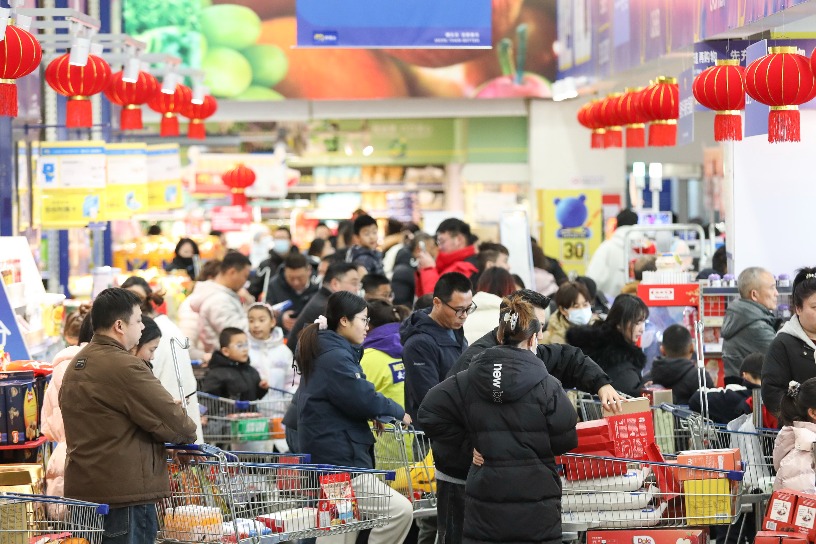US' planned port docking fees on China set to backfire
Shipping: Additional costs to be passed on to customers

The United States' plan to impose port docking fees on Chinese ships will backfire on its own economy and lead to a redistribution of shipping capacity between the two countries, said shipping analysts and a risk assessment report on Thursday.
The Office of the US Trade Representative proposed in late February a measure to charge a fee of up to $1.5 million for Chinese-operated and Chinese-built vessels making port calls in the US.
China has urged the US to immediately halt the misguided action, emphasizing that such measures will drive up global shipping costs, disrupt the stability of global industrial and supply chains, and heighten inflationary pressures within the US.
Since the container shipping industry is relatively downstream in the supply chain and has weaker bargaining power, these additional costs are likely to be passed on to US consumers, shifting the burden to end customers, said Zhou Dequan, chief economist at the Shanghai International Shipping Institute.
Zhou said this will weigh on US inflation, as well as downstream retailers, wholesalers and other businesses.
"Furthermore, the proposed port calling fee will not only affect Chinese shipping companies like China COSCO Shipping Corp, but will also have a broad impact on most global liner operators," he added.
"According to the US plan, if more than 50 percent of a shipping company's vessels consist of ships built in China, they will be subject to the fee," Zhou said, emphasizing that under such circumstances, the operations of major players, including France's CMA CGM Group, Germany's Hapag-Lloyd AG and Denmark's Maersk Line would be affected.
The Washington-based World Shipping Council estimated that the port fees proposed by the Office of the US Trade Representative could add $600 to $800 per container, with the additional costs inevitably passed on to end consumers, which means that US businesses and consumers will have to pay the price of increased shipping costs.
The council said that these fees, if imposed, would amount to an additional tax on US consumers of up to $30 billion a year.
According to a report by Ningbo Customs in Zhejiang province, the port calling fee, if implemented, would reduce direct China-US shipping capacity while prompting the development of alternative routes, such as Southeast Asia-US and China-Europe routes.
In the short term, this reallocation could create an imbalance in route distribution. As a result, Chinese-manufactured vessels are likely to focus on non-US routes, while US and European shipping companies operating non-Chinese-manufactured vessels would dominate US-bound routes, the study said.
The report found that this might prompt businesses to reduce calls at small and medium-sized US ports, instead concentrating shipments through major ports such as Los Angeles and Long Beach to lower per-trip costs. This severe imbalance between supply and demand could further disrupt the global shipping industry.
Soren Toft, CEO of Switzerland-based MSC Group, one of the world's largest shipping service providers by sales revenue, said last week at a conference in Long Beach, California, that to avoid incurring additional fees, shipping companies may adjust their routes and capacity deployment accordingly.
He said that a typical service route from Asia to the east coast of the US involves most carriers deploying vessels ranging from 8,000 to 15,000 TEUs (twenty-foot equivalent units) and making stops at four ports, which would result in fees amounting to $4 million for such a journey.
Logistics diversification
Xu Kai, a researcher at Shanghai Maritime University who specializes in shipping operations, said that in the long run, the US port-call fee increase would accelerate the trend of global logistics diversification, with Southeast Asia, India and Mexico emerging as new hubs, driven by China's surging goods volume and demand for transit services.
He added that the global shipping industry is likely "to undergo restructuring, with small and medium-sized shipping companies potentially exiting trans-Pacific routes, while large groups reinforce their dominance through regional cooperation".
Freight forwarding businesses in Ningbo and neighboring cities in Zhejiang province said that the ongoing changes in US tariff policies are having a significant impact on the volume of goods exported from Chinese companies to the US, according to the Ningbo Customs report.
In particular, the immediate implementation of certain tariff increases has made Chinese exporters hesitant to ship goods to the US. As a result, cargo volume on US-bound routes has plummeted, leading to heightened market uncertainty, the report said.



































